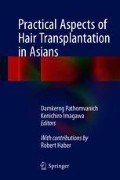Abstract
The overall shape of the hairline and the proper ratio of the forehead to the entire face are important factors for defining a balanced and attractive face. Women with M-shaped hairlines look more masculine, especially in Asians. In addition, women with high hairlines look somewhat masculine and older than their years. For this reason, hair transplantation for female hairline correction is gaining more and more popularity in women.
Hair transplantation for female hairline correction can be classified by purpose into four types: the correction of an M-shaped hairline, hairline lowering, forehead width reduction, and sideburn augmentation. Since women with an M-shaped hairline are perceived to impart a masculine image especially in Asia, the correction of an M-shaped hairline is the most popular indication among Asian women.
With respect to the shape of the hairline, the oval type is preferred as the ideal female hairline especially in Asia. Meanwhile, the top of the vertical one third of the face or 5.5–6 cm from the midpoint between the eyebrows is generally considered as the appropriate height for the new frontal hairline. Importantly, the temporal peak should also be reconstructed in Asian women with a wide or round face.
The use of fine hairs is also critically important to reconstructing a natural-looking female hairline. Additionally, the novel technique using a hair removal laser is a simple yet an effective way to create fine hairs at the hairline subsequent to the hair transplantation for female hairline correction in Asians with thick donor hairs.
References
Holcomb JD, McCollough EG. Trichophytic incisional approaches to upper facial rejuvenation. Arch Facial Plast Surg. 2001;3:48–53.
Ramirez AL, Ende KH, Kabaker SS. Correction of the high female hairline. Arch Facial Plast Surg. 2009;11:84–90.
Marten TJ. Hairline lowering during foreheadplasty. Plast Reconstr Surg. 1999;103(1):224–36.
Jung JH, Rah DK, Yun IS. Classification of the female hairline and refined hairline correction techniques for Asian women. Dermatol Surg. 2011;37:495–500.
Nusbaum BP, Fuentefria S. Naturally occurring female hairline patterns. Dermatol Surg. 2009;35:907–13.
McKinney P, Mossie RD, Zukowski ML. Criteria for the forehead lift. Aesth Plast Surg. 1991;15:141–7.
Hwang ST. Hair transplantation in east Asians. In: Unger WP, Shapiro RS, Unger R, Unger M, editors. Hair transplantation. 5th ed. New York: Informa Healthcare; 2011. p. 428–30.
Kyle K. Botulinum toxin for Asians. Berlin: Springer; 2016.
Farjo B. Estimating graft numbers made easy for the recipient site. H T Forum Int. 2001;11:101.
Kim JC. Asian Hair. In: Pathomvanich D, Imagawa K, editors. Hair restoration surgery in Asians. Berline: Springer; 2010. p. 21–2.
Shapiro R. Principles of creating a natural hairline. In: Unger WP, Shapiro RS, Unger R, Unger M, editors. Hair transplantation. 5th ed. New York: Informa Healthcare; 2011. p. 374–82.
Bernstein RM, Rassman WR. Recipient site grafts and incisions. In: Unger WP, Shapiro R, editors. Hair transplantation. 4th ed. New York: Marcel Dekker, Inc.; 2004. p. 388–408.
Kang H, Kang TW, Lee SD, Park YM, Kim HO, Kim SY. The changing patterns of hair density and thickness in south Korean women with hair loss: clinical office-based phototrichogram analysis. Int J Dermatol. 2009;48:14–21.
Swinehart JM. “cloned” hairlines: the use of bisected hair follicles to create finer hairlines. Dermatol Surg. 2001;27:868–72.
Kim JC, Choi YC. Regrowth of grafted human scalp hair after removal of the bulb. Dermatol Surg. 1995;21:312–3.
Jones R. Body hair transplant into wide donor scar. Dermatol Surg. 2008;34:857.
Umar S. The transplanted hairline: leg room for improvement. Arch Dermatol. 2012;148:239–42.
Park HS, Kim JY, Choe YS, Han W, An JS, Seo KK. Alternative method for creating fine hairs with hair removal laser in hair transplantation for hairline correction. Ann Dermatol. 2015;27(1):21–5.
Author information
Authors and Affiliations
Corresponding author
Editor information
Editors and Affiliations
Rights and permissions
Copyright information
© 2018 Springer Japan KK, part of Springer Nature
About this chapter
Cite this chapter
Seo, K.K. (2018). Hair Transplantation for Female Hairline in Asian Women. In: Pathomvanich, D., Imagawa, K. (eds) Practical Aspects of Hair Transplantation in Asians. Springer, Tokyo. https://doi.org/10.1007/978-4-431-56547-5_52
Download citation
DOI: https://doi.org/10.1007/978-4-431-56547-5_52
Published:
Publisher Name: Springer, Tokyo
Print ISBN: 978-4-431-56545-1
Online ISBN: 978-4-431-56547-5
eBook Packages: MedicineMedicine (R0)

